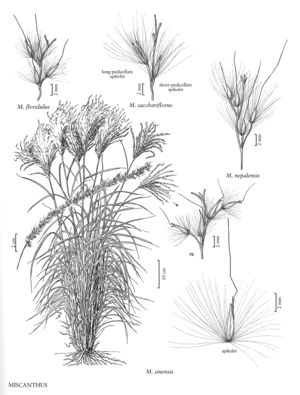Difference between revisions of "Miscanthus sacchariflorus"
FNA>Volume Importer |
FNA>Volume Importer |
||
| Line 17: | Line 17: | ||
-->{{Treatment/Body | -->{{Treatment/Body | ||
|distribution=Mass.;Ont.;Que.;Mo.;Minn.;Mich.;Nebr.;Wis.;N.Y.;Ill.;Conn.;Maine;Iowa | |distribution=Mass.;Ont.;Que.;Mo.;Minn.;Mich.;Nebr.;Wis.;N.Y.;Ill.;Conn.;Maine;Iowa | ||
| − | |discussion=<p | + | |discussion=<p>Miscanthus sacchariflorus is native to the margins of rivers or marshes in temperate to north-temperate regions of eastern Asia, and appears to require cold and humidity for optimum growth. It has escaped from cultivation in various parts of the Flora region. It combines a large, plumose panicle with recurving leaves that turn orange in the fall.</p> |
|tables= | |tables= | ||
|references= | |references= | ||
| Line 33: | Line 33: | ||
|basionyms= | |basionyms= | ||
|family=Poaceae | |family=Poaceae | ||
| + | |illustrator=Linda A. Vorobik and Cindy Roché | ||
|distribution=Mass.;Ont.;Que.;Mo.;Minn.;Mich.;Nebr.;Wis.;N.Y.;Ill.;Conn.;Maine;Iowa | |distribution=Mass.;Ont.;Que.;Mo.;Minn.;Mich.;Nebr.;Wis.;N.Y.;Ill.;Conn.;Maine;Iowa | ||
|reference=None | |reference=None | ||
| Line 38: | Line 39: | ||
|publication year= | |publication year= | ||
|special status= | |special status= | ||
| − | |source xml=https:// | + | |source xml=https://bibilujan@bitbucket.org/aafc-mbb/fna-data-curation.git/src/314eb390f968962f596ae85f506b4b3db8683b1b/coarse_grained_fna_xml/V25/V25_1516.xml |
|subfamily=Poaceae subfam. Panicoideae | |subfamily=Poaceae subfam. Panicoideae | ||
|tribe=Poaceae tribe Andropogoneae | |tribe=Poaceae tribe Andropogoneae | ||
Revision as of 17:16, 30 October 2019
Plants rhizomatous, rhizomes 3-6 mm wide. Culms 60-250 cm tall, 5-8 mm thick below; nodes pilose. Leaves evenly distributed; ligules 0.5-1 mm; blades 20-80 cm long, 0.5-3 cm wide, adaxial surfaces densely pilose basally, midribs prominent, whitish. Panicles 15-40 cm long, 8-16 cm wide, white to yellowish-brown, usually with more than 15 branches; rachises 4-10 cm; nodes pilose; branches 10-35 cm long, about 10 mm wide, sometimes branching at the base. Shorter pedicels 1.5-3 mm; longer pedicels 3-7 mm, strongly curved at maturity. Spikelets 4-6 mm; callus hairs 2-4 times as long as the spikelets, copious, white. Lower glumes 2-keeled above, margins densely pilose distally, hairs to 15 mm; upper glumes 4-5 mm, 3-veined, margins ciliate distally; awns of upper lemmas absent or short, not exceeding the glumes. 2n = 38, 57, 64, 76, 95.
Distribution
Mass., Ont., Que., Mo., Minn., Mich., Nebr., Wis., N.Y., Ill., Conn., Maine, Iowa
Discussion
Miscanthus sacchariflorus is native to the margins of rivers or marshes in temperate to north-temperate regions of eastern Asia, and appears to require cold and humidity for optimum growth. It has escaped from cultivation in various parts of the Flora region. It combines a large, plumose panicle with recurving leaves that turn orange in the fall.
Selected References
None.
